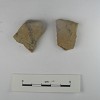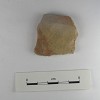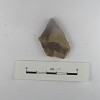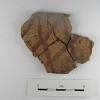
| Culture | Branch | Tradition | Ware | Type |
| Ancestral Pueblo: Southern Colorado Plateau (Anasazi) | Central Anasazi | Chaco and Cibola | Chaco-Cibola White Ware | Tohatchi Red-on-brown |
Type Name: Tohatchi Red-on-brown |
|
| Period: | 550 A.D. - 600 A.D. |
| Culture: | Ancestral Pueblo: Southern Colorado Plateau (Anasazi) |
| Branch: | Central Anasazi |
| Tradition: | Chaco and Cibola |
| Ware: | Chaco-Cibola White Ware |
First posted by C. Dean Wilson 2012
Tohatchi Red-on-brown was defined by Reed and Goff (1998). This type developed out of early brown ware forms and represents the earliest painted type produced in the Colorado Plateau (Reed and Goff 1998; Reed and others 2000). Tohatchi Red-on-brown appears to essentially represent a painted brown ware and developed out of Obelisk Brown and Tohatchi Red. It is extremely rare, as it is present in a limited area where it appears to have quickly developed into early forms of La Plata Black-on-white which quickly spread across the Colorado Plateau. Tohatchi Red-on-brown has been identified in contexts in the Southern Chuska Valley and has also been noted in the Cove-Redrock Valley and Prayer Rock district in northeastern Arizona (Reed and others 2000). The production of this type was very short-lived probably spanning from about A.D. 550 to 600, and is the earliest painted type produced in the Colorado Plateau. Pottery illustrated as Tohatchi Red-on-brown include both examples resembling Obelisk Gray but with simple painted decorations as well as those exhbiting characteristics similar to those noted for La Plata Black-on-white but with designs executed in red paint, and thus seems to reflect a continuum of development between these two types as usually defined. Examples of painted pottery reflecting this shift in technological and decorative conventions seem to be represented by forms sometimes been placed into a Transitional Tohatchi/La Plata Black-on-white category. Pottery assigned to this category are most similar to pottery classified as La Plata Black-on-white, except for the application of desings in a clay/hamite pigment as identied for Tohatchi Red-on-brown.
Pastes noted in examples of Tohatchi Red-on-brown fire to a yellow-red color and are soft, silty and friable. Surfaces are buff to brown. Temper consists of naturally occurring silt and occasionally added sand and sandstone. Decorations are applied in thick deep red pigment which is probably a mixture of clay and hematite over a polished brown surface. Painted decorations consist of broad lines that may have been applied directly on fingers rather than by brush. Some of the lines seem to exhibit rectilinear patterns while others seem represent crude anthromorph figures (Reed and others 2000). The majority of Tohatchi Red-on-brown sherds noted is from bowls although some sherds are from jars. While this type is similar to Mogollon Red-on-brown from the Mogollon region, it does not appear to have developed directly out of this type.
References:
Reed, Lori S., and Joell Goff
1998 Appendix C: Formal Description of Tohatchi Red-on-brown and Tohatchi Red. In Exploring Ceramic Production, Distribution, and Exchange in the Southern Chuska Valley: Analytical Results from the El Paso Natural Gas North Expansion Project, by L.S. Reed, J. Goff,, and K. N. Hensler, pp. C1-C6.Pipeline Archaeology 1990-1993: The El Paso Natural Gas System Expansion Project, New Mexico and Arizona, Vol XI, Book 2, Report no, WCRM (F)74, Farmington.
Reed, Lori C., Dean Wilson, and Kelley Hays-Gilipin
2000 From Brown to Gray; The Origins of Ceramic Technology in the Northen Southwest. In Foundations of Anasazi Culture: The Basketmaker-Pueblo Transition, edited by P.F. Reed, pp. 19-45. The University of Utah Press, Salt Lake City.
Related Photos
 © New Mexico Office of Archaeological Studies, a division of the New Mexico Department of Cultural Affairs.
© New Mexico Office of Archaeological Studies, a division of the New Mexico Department of Cultural Affairs.
The Center for New Mexico Archaeology
7 Old Cochiti Road
Santa Fe, NM 87507
505-476-4404
Fax: 505-476-4448







